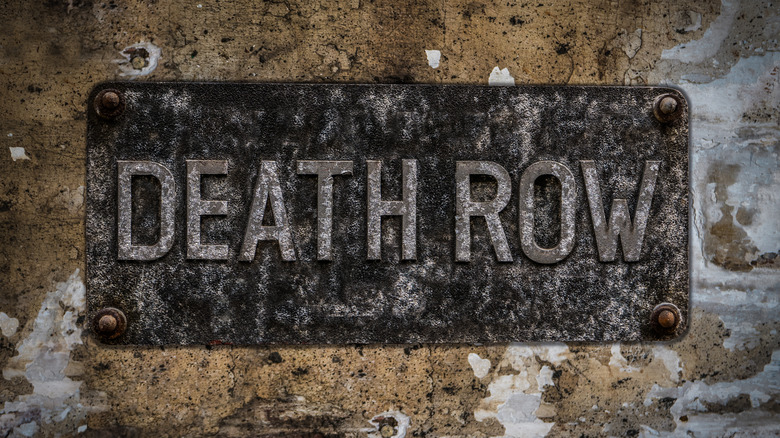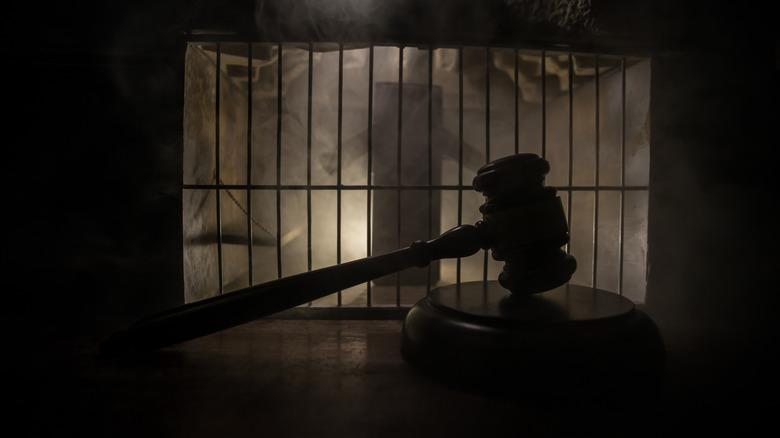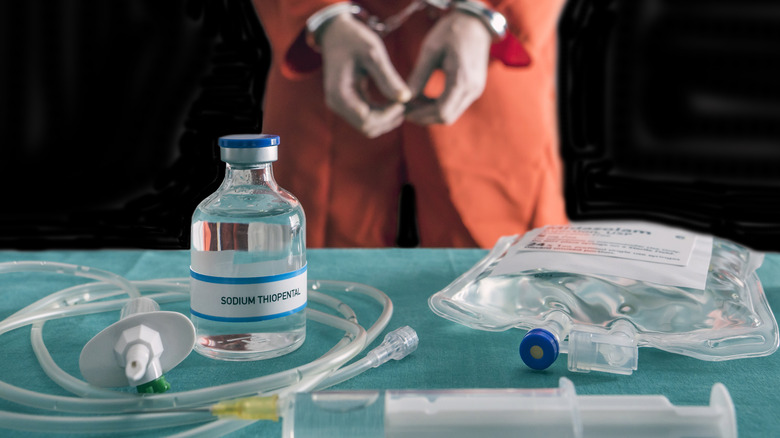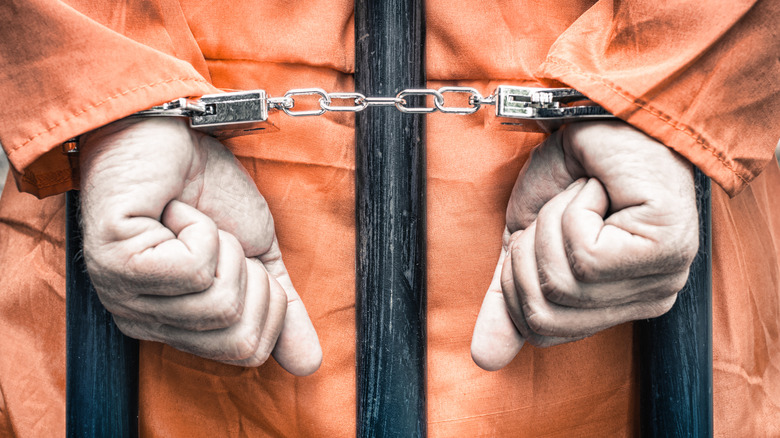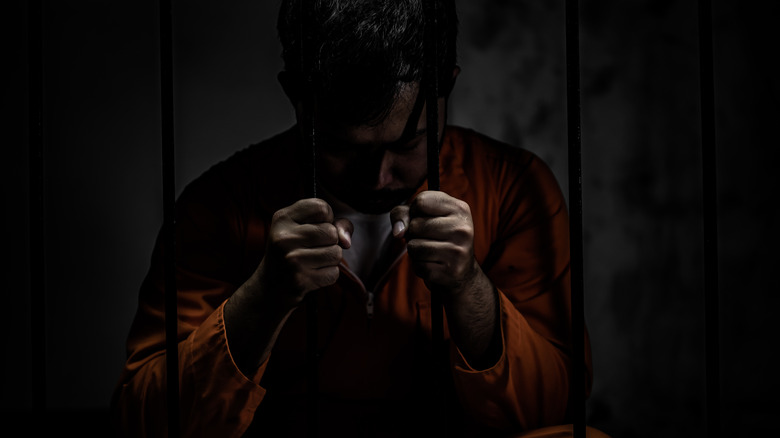Why Do People Sit On Death Row For So Long?
Death penalty laws have been around for centuries, and the British brought the idea of capital punishment when they settled in the Americas. According to History, the first person given the death penalty in the new colonies was Captain George Kendall, who was accused of being a spy for the Spaniards. He was executed in 1608. Back then, death sentences were carried out swiftly. As time passed, however, the length of time between sentencing and execution has only increased.
Research done by the Bureau of Justice Statistics showed that in 1984, death row inmates waited an average of about 6 years before they faced execution. That number significantly increased in 2020 when the average waiting period was reported to be 18.9 years. That same year, there were 2,469 death row inmates all across the United States, and the number of executions performed was 17. Despite a large number of death row inmates, the number of people sentenced to death has significantly decreased throughout the decades, as reported by Pew Research.
Crimes that are punishable by the death penalty
During colonial times, even minor criminal acts were punished by the death penalty. Some of these examples include killing chickens, stealing provisions, and trading with Native Americans. As years passed, laws were enacted and significant changes were made so that only the most heinous crimes were punishable by death. As reported by the Death Penalty Information Center, the majority of inmates on death row have murder convictions. Armed robbery and rape were other crimes where the death penalty was sought, but court rulings have since changed.
The death penalty is reserved for the worst of the worst, and other types of crimes that are punishable by execution include aggravated kidnapping, espionage, treason, drug trafficking, aircraft hijacking, aggravated assault by repeat offenders, and rape of a child. However, death penalty statutes differ for every state. Capital punishment is also not legal in all states; as of 2021, only 27 states authorize the death penalty (per the National Conference of State Legislatures).
The appeals process
One of the major reasons why inmates spend years on death row is the appeals process, which takes years. According to a report from NPR, many inmates on death row have been waiting since the 1970s and early '80s for their sentences to be carried out. According to Degen Clow, a criminal defense attorney, processing death row inmates' appeals has nine steps. These are enforced to ensure that those who are going to be put to death are, indeed, guilty of the crimes that they have been convicted of (via THV 11).
A 2014 article by the American Association for the Advancement of Science stated that about 4.1% of inmates on death row may be innocent of their crimes. Those convicted of capital punishment are given the chance to appeal their conviction or sentence. Defense attorneys have different options they can pursue, including reducing the sentence, requesting a new trial, motions for a mistrial, or motion for acquittal. As explained by Clow, the more issues that arise in an inmate's appeal, the more time it takes to process through the legal system. There are some who believe that the time it takes to go through appeals is justifiable, as it affords an inmate due process before the death sentence is carried out.
Procurement of drugs
The primary method of execution used is lethal injection, but there are states that authorize alternative ways including electrocution, firing squad, hanging, and lethal gas (via Death Penalty Information Center). Another reason why death row inmates spend decades waiting for execution is the difficulty of procuring drugs for lethal injection. Many drug manufacturers have prohibited the use of their products for execution, as they don't want their brand associated with killing people when they are in the business of saving lives.
Because of this, some have resorted to obtaining drugs through illicit means or less-than-reputable sources, which have resulted in botched executions, as reported by Pharmaceutical Technology. Some states have laws that allow them to keep the identity of their suppliers anonymous. Despite other legal methods of execution, lethal injection is still considered the "most humane" approach, but with the complications of acquiring drugs, death row inmates are left with no choice but to wait.
Execution volunteers
There have been instances wherein death row inmates waived their rights to appeal their case and instead opted for execution. Per the Death Penalty Information Center, there are different reasons why a prisoner volunteers for execution. Some of these reasons include bad prison conditions, the admittance of guilt, or simply wanting to hasten the process of death. Not all inmates who volunteer are granted their request, as there are conditions that must be met. One of them is that the inmate must be of sound mind when they make the decision to terminate their appeals.
In 2003, The Gainesville Sun reported that the number of inmates on death row seeking to drop their appeals has increased. Christopher Slobogin, a University of Florida law professor, said that prisoners have their own reasons for doing so, but one of them has to do with the time it takes to carry out their death sentence. "They don't want to wait any longer. It's the psychological pressure of knowing that eventually they are going to die," Slobogin stated.
The death row syndrome
In 2019, the number of senior inmates on death row significantly increased. Many of them aged in prison while waiting for their execution. Lawyers and psychologists argue that some death row inmates have developed a condition known as death row syndrome, which are psychological effects associated with the length of time they spend awaiting their execution. As Slate notes, it isn't an official clinical diagnosis; rather, it's a legal term.
Death row prisons around the country have varying conditions, but most of them are deemed to be harsh for prisoners. After all, the worst of the worst criminals are the ones subjected to capital punishment. A study conducted by psychiatrist Dr. Stuart Grassian on 14 inmates concluded that solitary confinement and the dire living conditions result in hallucinations, distortion in perceptions, and depression. The inmates Dr. Grassian studied weren't on death row, but the conditions were comparable to those awaiting execution. He concluded that those waiting for their execution during the lengthy appeals may develop the same psychological symptoms that can be seen as torture (via the University of San Diego). As the average waiting time for execution increases, questions are raised about whether or not the additional anguish death row inmates experience is constitutional.
